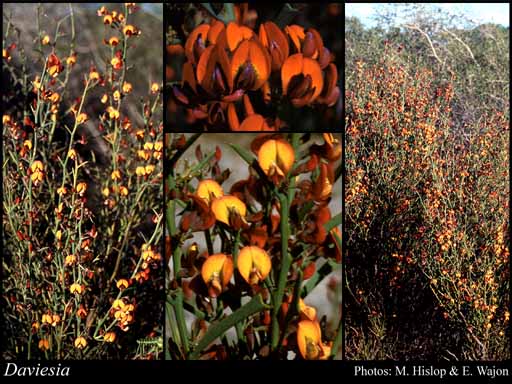- Reference
- Trans.Linn.Soc.London,Bot. 4:220 (1798)
- Name Status
- Current

Scientific Description
Family Papilionaceae. Mirbelieae.
Sometimes included in Leguminosae.
Habit and leaf form. Shrubs (mainly, mostly glabrous), or herbs; evergreen; without essential oils; not resinous. ‘Normal’ plants, or switch-plants; with the principal photosynthesizing function transferred to stems, or phyllodineous (the leaves when well developed often being readily identifiable as phyllodes). Leaves well developed (but phyllodinous), or much reduced (to phyllodes or scales, probably never truly absent). Plants spiny, or unarmed. The spines when present, axial, or foliar (phyllodes often pungent). The herbs perennial (e.g. the rushlike D. triflora). Leaves cauline. Plants with neither basal nor terminal concentrations of leaves; to 0.3–2 m high. Self supporting. Mesophytic, or xerophytic (mostly). Phyllodes flat, or semiterete, or terete, or solid/angular; leathery, or woody; unarmed, or spine-tipped, or modified into spines. Heterophyllous (the foliar members often conspicuously reducing along the branchlets), or not heterophyllous. Leaves minute to medium-sized; alternate (mostly), or opposite (e.g. D. oppositifolia), or opposite to whorled (e.g. D. ovata); spiral; in D. ovata 3 per whorl; decurrent on the stems (occasionally), or not decurrent on the stems; leathery, or membranous, or modified into spines; imbricate, or not imbricate; petiolate to sessile; non-sheathing; not gland-dotted; edgewise to the stem (commonly when phyllodineous), or with ‘normal’ orientation; simple; pulvinate, or epulvinate. Leaf blades i.e. phyllodes, dorsiventral, or isobilateral, or centric. Leaves with stipules (then minute), or without stipules. Leaf anatomy. Hairs present, or absent (mostly ostensibly glabrous); glandular hairs absent; complex hairs absent (peltate hairs absent). Branched hairs absent. Stem anatomy. Secondary thickening developing from a conventional cambial ring, or anomalous.
Reproductive type, pollination. Fertile flowers hermaphrodite. Unisexual flowers absent. Plants hermaphrodite. Entomophilous, or ornithophilous. Pollination mechanism conspicuously specialized.
Inflorescence and flower features. Flowers solitary, or aggregated in ‘inflorescences’; not crowded at the stem bases; when solitary, axillary; in racemes, or in umbels (false), or in corymbs, or in panicles. Inflorescences simple, or compound. The terminal inflorescence unit cymose, or racemose. Inflorescences axillary (mostly), or terminal (occasionally); of axillary racemes, modifying to false umbels, clusters or solitary flowers; with involucral bracts (section Involucratae), or without involucral bracts. Involucral bracts when present, persistent. The involucres accrescent (coming to enclose the fruit). Flowers pedicellate, or subsessile; bracteate (these not trifid; barren bracts present at the inflorescence bases, and the flowers articulated on the pedicels). Bracts persistent, or deciduous. Flowers ebracteolate; small to medium-sized (less than 2 cm); very irregular; zygomorphic. The floral asymmetry involving the perianth and involving the androecium. Flowers papilionaceous (imbricate-descending); basically 5 merous; tetracyclic. Floral receptacle developing a gynophore to with neither androphore nor gynophore (the ovary described as ‘shortly stipitate’). Free hypanthium present, or absent. Hypogynous disk present; intrastaminal. Perianth with distinct calyx and corolla; 10; 2 -whorled; isomerous. Calyx present; 5; 1 -whorled; gamosepalous; five lobed (sometimes ribbed). Calyx lobes markedly shorter than the tube. Calyx imbricate; exceeded by the corolla; campanulate; regular (more or less), or unequal but not bilabiate, or bilabiate (the upper two members often broader and more or less connate); neither appendaged nor spurred; non-fleshy; persistent; non-accrescent; with the median member anterior. Corolla present; 5; 1 -whorled; appendiculate, or not appendiculate. Standard not appendaged. Corolla partially gamopetalous. 2 of the petals joined (keel members only?). The joined petals anterior. The wings of the corolla free from the keel; not laterally spurred. Standard ‘normally’ developed; emarginate; not sericeous. Keel conspicuously exceeded by the wings; not long-acuminate/beaked (but often beaked); neither coiled nor spiralled; not bent and beaked. Corolla imbricate (descending); glabrous abaxially; plain, or with contrasting markings; yellow, or yellow and orange, or yellow and purple, or yellow and brown (generally yellow with a darker, reddish, purplish or brownish centre); non-accrescent. Petals clawed. Androecial members definite in number. Androecium 10. Androecial sequence not determinable. Androecial members free of the perianth; all equal to markedly unequal; free of one another (mostly, but the filaments are closely apposed, and rarely they are joined briefly at the base. The Perth Region description applies the strange useage of ‘coherent’ given in their glossary); 1 -whorled. Androecium exclusively of fertile stamens. Stamens 10; distinctly dissimilar in shape (the anthers dimorphic, and the filaments sometimes alternately thick and thin); diplostemonous; both opposite and alternating with the corolla members; filantherous. Anthers separate from one another, or connivent; dimorphic; alternately dorsifixed and basifixed; alternately versatile and non-versatile; dehiscing via longitudinal slits; latrorse, or introrse; tetrasporangiate. Pollen shed as single grains. Gynoecium 1 carpelled. The pistil 1 celled. Carpels reduced in number relative to the perianth. Gynoecium monomerous; of one carpel; superior. Carpel stylate; apically stigmatic. Style curved, or hooked, or bent. Style glabrous. Stigmatic tissue terminal. Carpel 2 ovuled. Placentation marginal. Gynoecium median. Ovary subsessile to stipitate (‘shortly stipitate’). Ovary summit glabrous. Styles hairless. Ovules pendulous to ascending; biseriate; arillate; anatropous, or campylotropous to amphitropous, or hemianatropous.
Fruit and seed features. Fruit aerial; 9–21 mm long; non-fleshy; not spinose. The fruiting carpel dehiscent; a legume. Pods somewhat elongated, or much elongated; (obliquely ob-) triangular (the posterior suture straight); straight; beaked, or not beaked; becoming inflated, or not becoming inflated; more or less flat to somewhat compressed; not constricted between the seeds; not transversely septate; wingless; not internally hairy. Valves of the dehisced pod not twisted. Fruit 1 celled; elastically dehiscent. Dispersal unit the seed. Seeds not triangular, not lobed; non-endospermic; not mucous; small to very large; arillate. Cotyledons 2; accumbent. Embryo bent (radicle inflexed). Testa hard; non-operculate; smooth; conspicuously colour-patterned (mottled). Micropyle zigzag, or not zigzag.
Special features. Calyx limb 5 lobed. Upper lip of calyx lobed; 2 lobed. Lower lip of calyx lobed; 3 lobed.
Geography, cytology, number of species. Native of Australia. A genus of about 200 species; 119 species in Western Australia.